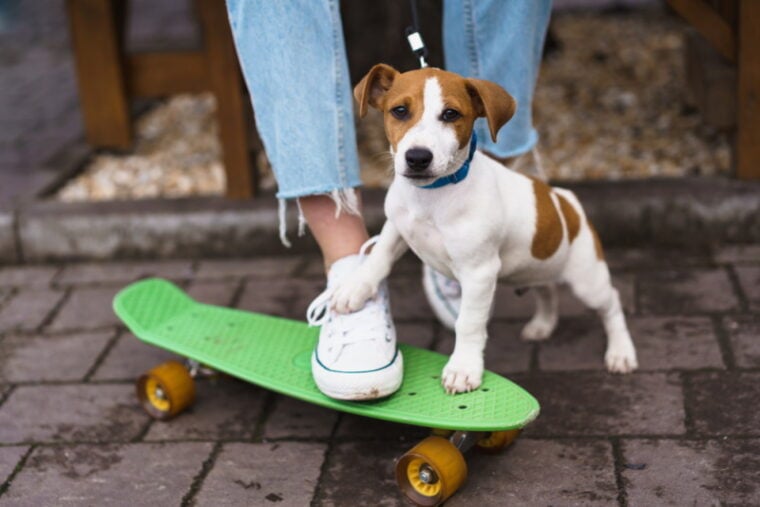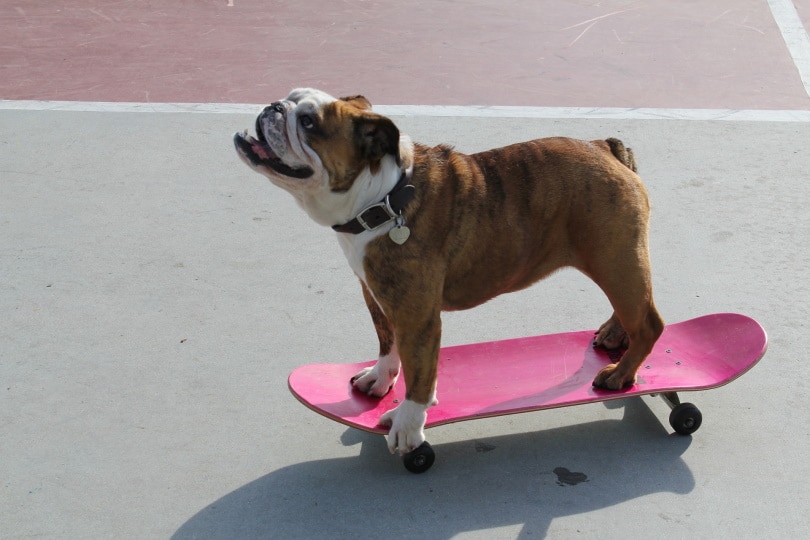
It’s fun to teach your dog new tricks, and it can be a great way for your dog to get its daily dose of exercise. However, some tricks and skills are a bit more impressive than others. Enter doggie skateboarding.
There are tons of videos on YouTube of dogs riding on skateboards and electric scooters. While this is definitely an impressive skill to teach your dog, it’s not necessarily the easiest one and it will take some persistence. That being stated, it is fairly doable if you have the time and patience. It also helps if your dog already has some obedience training and is at least an adolescent.
New pups under 6 months old and older dogs are more difficult to train and may not have the attention span needed for intricate skills and complicated commands. But if you’re looking to teach your dog how to ride a skateboard, keep reading.
How to Teach a Dog to Ride a Skateboard in 5 Steps
Here are some steps that’ll make it easy for you to set your dog up on the path to success. By following this list, you can help your dog become familiar and comfortable with the skateboard and keep it safe while teaching it how to ride.
1. Ensure That Your Dog Is a Good Fit for Skateboard Riding
When considering placing your dog on the skateboard, it’s important to ensure that your dog is in the best health to do so. This means that the dog is in good physical condition and not suffering from any physical ailments such as arthritis or other conditions. Note that some dog breeds will be a better fit for skateboard riding than other breeds; for example, breeds that have longer legs such as Huskies and Bulldogs as opposed to small Terriers or Chihuahuas.
2. Familiarize Your Dog with the Board
Dogs have no idea what a skateboard is, so you’ll need to familiarize your pup with it before actually placing them on top of the board. Simply set the board on the floor in front of your dog and let them explore on their own. Your dog will likely sniff the board, touch it with its paw, and even scratch it.
When the dog interacts with the board, be sure to give it a lot of verbal praise and even a treat to let it know that this is a positive interaction. In some cases, you may find that your dog will eventually stand on the board on its own.

3. Let It Stand on the Board
Next, place the board at a location where it can be completely stationary, even after the dog is placed on top of it. You may need to set weights on all four sides of the board to keep it from moving or tipping over while the dog is on it. It’s also helpful to place it on top of a rug if you’re indoors, or on the grass, if you’re outdoors.
4. Let It Roll
When your dog looks comfortable standing on the board, move the weights from around it and. while holding on to it, roll it a few inches from left to right. This may initially frighten your dog and it may jump off, so you may need to try this for a few days until it becomes more familiar with the movement. Positive reinforcement with verbal cues and treats help. So, if the dog jumps off the board, place a treat on the board, place the dog back on the board, and then give it a treat or praise it to acknowledge the action. Again, it’s all about positive reinforcement in this stage.

5. Introduce a Cue or Command
Now it’s time to take off the training wheels. Set the skateboard on a flat floor or pavement so that it can roll freely. Next, slowly roll the skateboard with the dog on it but before you do, be sure to call out a verbal command such as “Go” or “Skate” beforehand. Doing so will alert the dog to the movement.
The dog may jump off the first few times, but positive reinforcement will help as you continue to progress with this step. Once the dog has mastered this command and become more comfortable with rolling on the skateboard, it’s simply a matter of building up its resistance so it can roll for a longer period.
Note that you’ll want to make sure that you placed the board on a level surface so that it doesn’t roll downhill, into traffic, or into objects such as trees, cars, or fire hoses.
Safety Tips When Teaching Your Dog to Skateboard
Just like with humans, skateboarding for dogs can be a very dangerous activity. So, it’s important to exercise caution and use your best judgment before placing your dog on a skateboard. Here are some other tips to note.

Wrapping Up
Skateboarding is not a typical trick to teach your dog. But with a little patience and by following these tips, you should be able to teach your dog how to skateboard in no time. Just remember to pay attention to your dog and make sure that your dog stays safe.
Featured Image Credit: taras.chaban, Shutterstock







